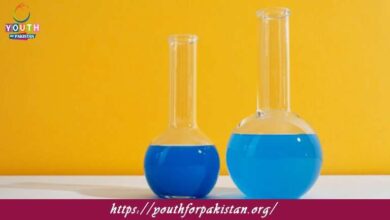12th Class Chemistry Chapter 9 MCQs with Answers

Prepare thoroughly with 12th Class Chemistry Chapter 9 MCQs on Hydrocarbons. These questions explore aromatic and aliphatic hydrocarbons, reactions, and properties. Keywords like hydrocarbon quiz, chemistry MCQs prep, and aromatic compounds test boost rankings and understanding.
Hydrocarbons are organic compounds composed of:
a) Carbon and nitrogen
b) Carbon and hydrogen
c) Carbon and oxygen
d) Carbon and sulfur
Which of the following is the simplest hydrocarbon?
a) Methane
b) Ethane
c) Propane
d) Butane
The hydrocarbon “C2H6” is named as:
a) Ethane
b) Ethene
c) Ethyne
d) Methane
The molecular formula of methane is:
a) CH2
b) C2H4
c) C3H6
d) CH4
Which of the following is an unsaturated hydrocarbon?
a) Methane
b) Ethane
c) Ethene
d) Propane
Hydrocarbons that contain only single bonds are called:
a) Saturated hydrocarbons
b) Unsaturated hydrocarbons
c) Aromatic hydrocarbons
d) Aliphatic hydrocarbons
The general formula of alkanes is:
1
a) CnH2n
b) CnH2n+2
c) CnH2n-2
d) CnH2n+4
The general formula of alkenes is:
a) CnH2n
b) CnH2n+2
c) CnH2n-2
d) CnH2n+4
The general formula of alkynes is:
a) CnH2n
b) CnH2n+2
c) CnH2n-2
d) CnH2n+4
Hydrocarbons can be classified into:
a) Alkanes, alkenes, and alkynes
b) Aliphatic and aromatic hydrocarbons
c) Saturated and unsaturated hydrocarbons
d) All of the above
Which of the following is an example of an alkane?
a) Ethene
b) Propene
c) Butane
d) Benzene
Which of the following is an example of an alkene?
a) Ethane
b) Propane
c) Ethene
d) Methane
Which of the following is an example of an alkyne?
a) Ethane
b) Propane
c) Ethyne
d) Methane
Alkanes contain only:
a) Single bonds
b) Double bonds
c) Triple bonds
d) Aromatic rings
Alkenes contain at least one:
a) Single bond
b) Double bond
c) Triple bond
d) Aromatic ring
Alkynes contain at least one:
a) Single bond
b) Double bond
c) Triple bond
d) Aromatic ring
The carbon-carbon single bond in alkanes allows for:
a) Free rotation around the bond axis
b) Restricted rotation around the bond axis
c) No rotation around the bond axis
d) Formation of double bonds
The carbon-carbon double bond in alkenes is formed by the sharing of:
a) One pair of electrons
b) Two pairs of electrons
c) Three pairs of electrons
d) Four pairs of electrons
The carbon-carbon triple bond in alkynes is formed by the sharing of:
a) One pair of electrons
b) Two pairs of electrons
c) Three pairs of electrons
d) Four pairs of electrons
The process of converting alkanes into alkenes by breaking carbon-carbon single bonds is called:
a) Substitution
b) Addition
c) Hydrogenation
d) Dehydrogenation
The process of converting alkenes into alkanes by adding hydrogen across the carbon- carbon double bond is called:
a) Substitution
b) Addition
c) Hydrogenation
d) Dehydrogenation
The reaction between alkenes and bromine water results in the decolorization of the solution due to:
a) Reduction of bromine
b) Oxidation of bromine
c) Formation of an insoluble precipitate
d) Formation of a soluble complex
Which of the following is a common industrial process for producing alkenes from alkanes?
a) Dehydration
b) Hydrogenation
c) Cracking
d) Halogenation
Alkynes can undergo hydrogenation to form:
a) Alkanes
b) Alkenes
c) Cycloalkanes
d) Alcohols
The process of converting alkynes into alkenes by breaking carbon-carbon triple bonds is called:
a) Substitution
b) Addition
c) Hydrogenation
d) Dehydrogenation
The reaction between alkynes and bromine water results in the decolorization of the solution due to:
a) Reduction of bromine
b) Oxidation of bromine
c) Formation of an insoluble precipitate
d) Formation of a soluble complex
Hydrocarbons are found in:
a) Natural gas and petroleum
b) Fruits and vegetables
c) Water bodies
d) Rocks and minerals
The prefix “eth-” in ethane indicates that the molecule contains:
a) One carbon atom
b) Two carbon atoms
c) Three carbon atoms
d) Four carbon atoms
Which of the following hydrocarbons is found in natural gas and is used as a fuel?
a) Ethane
b) Propane
c) Butane
d) Methane
Which of the following hydrocarbons is used as a refrigerant and aerosol propellant?
a) Ethane
b) Propane
c) Butane
d) Methane
Which of the following hydrocarbons is used as a raw material in the production of ethylene, a widely used industrial chemical?
a) Ethane
b) Propane
c) Butane
d) Methane
The prefix “prop-” in propane indicates that the molecule contains:
a) One carbon atom
b) Two carbon atoms
c) Three carbon atoms
d) Four carbon atoms
The prefix “but-” in butane indicates that the molecule contains:
a) One carbon atom
b) Two carbon atoms
c) Three carbon atoms
d) Four carbon atoms
The prefix “pent-” in pentane indicates that the molecule contains:
a) One carbon atom
b) Two carbon atoms
c) Three carbon atoms
d) Five carbon atoms
The prefix “hex-” in hexane indicates that the molecule contains:
a) One carbon atom
b) Two carbon atoms
c) Three carbon atoms
d) Six carbon atoms
The prefix “hept-” in heptane indicates that the molecule contains:
a) One carbon atom
b) Two carbon atoms
c) Three carbon atoms
d) Seven carbon atoms
Which of the following hydrocarbons has the highest number of carbon atoms?
a) Methane
b) Ethane
c) Propane
d) Octane
Which of the following hydrocarbons is commonly used as a gasoline additive to improve engine performance?
a) Ethane
b) Propane
c) Butane
d) Octane
The process of converting hydrocarbons into smaller, more useful molecules is called:
a) Hydrogenation
b) Dehydrogenation
c) Cracking
d) Polymerization
Which of the following hydrocarbons is commonly used as a fuel for heating and cooking?
a) Ethane
b) Propane
c) Butane
d) Octane
Which of the following hydrocarbons is commonly used as a refrigerant and aerosol propellant?
a) Ethane
b) Propane
c) Butane
d) Octane
Which of the following hydrocarbons is commonly used as a raw material in the production of plastics?
a) Ethane
b) Propene
c) Butene
d) Octene
The process of converting alkanes into alkenes by breaking carbon-carbon single bonds is called:
a) Substitution
b) Addition
c) Hydrogenation
d) Dehydrogenation
The reaction between alkanes and halogens (e.g., chlorine or bromine) results in:
a) Reduction of the halogen
b) Oxidation of the halogen
c) Formation of an insoluble precipitate
d) Formation of a soluble complex
Hydrocarbons with multiple carbon-carbon bonds are called:
a) Saturated hydrocarbons
b) Unsaturated hydrocarbons
c) Aromatic hydrocarbons
d) Aliphatic hydrocarbons
The hydrocarbon “C6H6” is named as:
a) Hexane
b) Hexene
c) Benzene
d) Cyclohexane
The molecular formula of benzene is:
a) CH3
b) C6H4
c) C6H6
d) C6H10
Benzene is an example of:
a) Alkane
b) Alkene
c) Alkyne
d) Aromatic hydrocarbon
Aromatic hydrocarbons are characterized by:
a) Multiple carbon-carbon single bonds
b) Multiple carbon-carbon double bonds
c) Multiple carbon-carbon triple bonds
d) A stable ring structure and alternating single and double bonds
The carbon atoms in a benzene ring are bonded together in a:
a) Linear chain
b) Branched chain
c) Cyclic structure
d) Three-dimensional network
Which of the following is an example of an aromatic hydrocarbon?
a) Ethane
b) Propene
c) Benzene
d) Butane
Benzene is used as a raw material in the production of:
a) Plastics and polymers
b) Fats and oils
c) Nucleic acids
d) Proteins and enzymes
The process of converting benzene into alkylbenzenes (e.g., toluene) is called:
a) Alkylation
b) Dehydration
c) Hydrogenation
d) Oxidation
The prefix “tolu-” in toluene indicates that the molecule contains:
a) One methyl group
b) Two methyl groups
c) Three methyl groups
d) Four methyl groups
The prefix “xyl-” in xylene indicates that the molecule contains:
a) One methyl group
b) Two methyl groups
c) Three methyl groups
d) Four methyl groups
Which of the following is an example of an aromatic hydrocarbon commonly used as a solvent and in the production of plastics and resins?
a) Ethene
b) Propene
c) Styrene
d) Butene
The prefix “styrene-” in styrene indicates that the molecule contains:
a) One phenyl group
b) Two phenyl groups
c) Three phenyl groups
d) Four phenyl groups
Which of the following is an example of an aromatic hydrocarbon commonly used in the production of dyes and pharmaceuticals?
a) Ethene
b) Propene
c) Benzene
d) Aniline
The prefix “anil-” in aniline indicates that the molecule contains:
a) One phenyl group
b) Two phenyl groups
c) Three phenyl groups
d) Four phenyl groups
Aromatic hydrocarbons are known for their:
a) High reactivity
b) Low reactivity
c) Strong odor
d) Colorless appearance
If you are interested to enhance your knowledge regarding Physics, Chemistry, Biology, and Computer please click on the link of each category, you will be redirected to dedicated website for each category.




